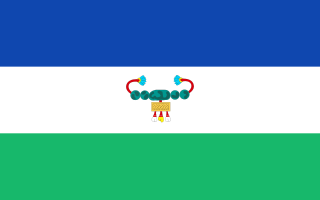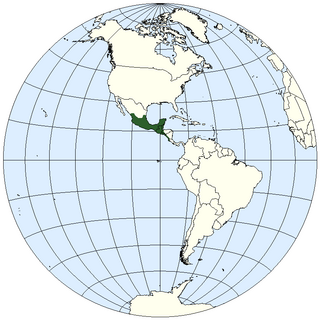
Central America is a subcontinent of North America. Its boundaries are defined as bordering Mexico to the north, Colombia to the south, the Caribbean Sea to the east, and the Pacific Ocean to the west. Central America consists of seven countries: Belize, Costa Rica, El Salvador, Guatemala, Honduras, Nicaragua, and Panama. Within Central America is the Mesoamerican biodiversity hotspot, which extends from northern Guatemala to central Panama. Due to the presence of several active geologic faults and the Central America Volcanic Arc, there is a high amount of seismic activity in the region, such as volcanic eruptions and earthquakes which has resulted in death, injury, and property damage.

The Mayan languages form a language family spoken in Mesoamerica, both in the south of Mexico and northern Central America. Mayan languages are spoken by at least 6 million Maya people, primarily in Guatemala, Mexico, Belize, El Salvador and Honduras. In 1996, Guatemala formally recognized 21 Mayan languages by name, and Mexico recognizes eight within its territory.

The Nawa people, also academically referred to as Pipil, are an indigenous group of Mesoamerican people inhabiting the western and central areas of present-day El Salvador, which they refer to as Kuskatan, later referred to as "Cuzcatlan" by the Spanish and their Indian auxiliaries the Mexica and Tlaxcalan. Although very few speakers are now left, they speak the Nawat language, which belongs to the Nahuatl dialect group. This dialect group stretches from Durango in Mexico to El Salvador, and historically as far as the Nicoya Peninsula of Costa Rica. According to Spanish chronicler Gonzalo Francisco de Oviedo, the Nawapipiltin, along with the neighboring Nicarao and Nonualco people, migrated from Mexico to their present locations beginning around the 8th century A.D., after the Chichimeca-Toltec civil war. As they settled in the area, they founded the city-state of Kuskatan, which was already home to various groups including the Lenca, Poqomam, and Xinca. The Nawas are closely related to the neighboring Nicarao people from Nicaragua, who branched off around 700-800 CE when they continued migrating south. They also spoke a version of Nawat, which would become the lingua franca in Central America during the Spanish colonial era. A hybrid form of Nawat-Spanish was spoken by many Nicaraguans up until the 19th century when it became extinct there, but is still around in parts of El Salvador, although still critically endangered.

Obsidian is a naturally formed volcanic glass that was an important part of the material culture of Pre-Columbian Mesoamerica. Obsidian was a highly integrated part of daily and ritual life, and its widespread and varied use may be a significant contributor to Mesoamerica's lack of metallurgy. Lithic and contextual analysis of obsidian, including source studies, are important components of archaeological studies of past Mesoamerican cultures and inform scholars on economy, technological organization, long-distance trade, ritual organization, and socio-cultural structure.

Mesoamerican chronology divides the history of prehispanic Mesoamerica into several periods: the Paleo-Indian ; the Archaic, the Preclassic or Formative (2500 BCE – 250 CE), the Classic (250–900 CE), and the Postclassic (900–1521 CE); as well as the post European contact Colonial Period (1521–1821), and Postcolonial, or the period after independence from Spain (1821–present).

Mesoamerican calendars are the calendrical systems devised and used by the pre-Columbian cultures of Mesoamerica. Besides keeping time, Mesoamerican calendars were also used in religious observances and social rituals, such as for divination.

Mesoamerican languages are the languages indigenous to the Mesoamerican cultural area, which covers southern Mexico, all of Guatemala and Belize and parts of Honduras and El Salvador and Nicaragua. The area is characterized by extensive linguistic diversity containing several hundred different languages and seven major language families. Mesoamerica is also an area of high linguistic diffusion in that long-term interaction among speakers of different languages through several millennia has resulted in the convergence of certain linguistic traits across disparate language families. The Mesoamerican sprachbund is commonly referred to as the Mesoamerican Linguistic Area.
The Mesoamerica Integration and Development Project, or in Spanish Proyecto Mesoamérica (PM), is a mechanism by which 10 countries centered on Central America implement regional projects for development and integration. The 10 participating countries are Belize, Colombia, Costa Rica, Dominican Republic, El Salvador, Guatemala, Honduras, Mexico, Nicaragua and Panama. The initiative was championed by the then-Mexican President, Vicente Fox. It is the successor to the Puebla-Panama Plan (PPP) first announced in 2001. The Mesoamerica Integration and Development Project was launched under that name in 2008.

The Mesoamerican Barrier Reef System (MBRS), also popularly known as the Great Mayan Reef or Great Maya Reef, is a marine region that stretches over 1,126 kilometres (700 mi) along the coasts of four countries – Mexico, Belize, Guatemala, and Honduras – from Isla Contoy at the northern tip of the Yucatán Peninsula south to Belize, Guatemala and the Bay Islands of Honduras. The reef system includes various protected areas and parks including the Belize Barrier Reef, Arrecifes de Cozumel National Park, Hol Chan Marine Reserve (Belize), Sian Ka'an biosphere reserve, and the Cayos Cochinos Marine Park. Belize's coastline, including the Belize Barrier Reef, is home to approximately 30% of the Mesoamerican Barrier Reef System.

The emergence of metallurgy in pre-Columbian Mesoamerica occurred relatively late in the region's history, with distinctive works of metal apparent in West Mexico by roughly 800 CE, and perhaps as early as 600 CE. Metallurgical techniques likely diffused northward from regions in Central or South America via maritime trade routes; recipients of these metallurgical technologies apparently exploited a wide range of material, including alloys of copper-silver, copper-arsenic, copper-tin and copper-arsenic-tin.

The Americas, also known as America, are lands of the Western Hemisphere, composed of numerous entities and regions variably defined by geography, politics, and culture.

Mesoamerica is a historical region and cultural area in southern North America and most of Central America. It extends from approximately central Mexico through Belize, Guatemala, El Salvador, Honduras, Nicaragua, and northern Costa Rica. Within this region pre-Columbian societies flourished for more than 3,000 years before the Spanish colonization of the Americas. Mesoamerica was the site of two of the most profound historical transformations in world history: primary urban generation, and the formation of New World cultures out of the long encounters among indigenous, European, African and Asian cultures.
The Mesoamerican language area is a sprachbund containing many of the languages natively spoken in the cultural area of Mesoamerica. This sprachbund is defined by an array of syntactic, lexical and phonological traits as well as a number of ethnolinguistic traits found in the languages of Mesoamerica, which belong to a number of language families, such as Uto-Aztecan, Mayan, Totonacan, Oto-Manguean and Mixe–Zoque languages as well as some language isolates and unclassified languages known to the region.

The geography of Mesoamerica describes the geographic features of Mesoamerica, a culture area in the Americas inhabited by complex indigenous pre-Columbian cultures exhibiting a suite of shared and common cultural characteristics. Several well-known Mesoamerican cultures include the Olmec, Teotihuacan, the Maya, the Aztec and the Purépecha. Mesoamerica is often subdivided in a number of ways. One common method, albeit a broad and general classification, is to distinguish between the highlands and lowlands. Another way is to subdivide the region into sub-areas that generally correlate to either culture areas or specific physiographic regions.

Cotzumalhuapa archaeological culture is from the piedmont area of the Escuintla Department, Guatemala. The Cotzumalhuapa archaeological zone is near the town of Santa Lucía Cotzumalguapa.
Central America or Central American may refer to:

The Huastec civilization was a pre-Columbian civilization of Mesoamerica, occupying a territory on the Gulf coast of Mexico that included the northern portion of Veracruz state, and neighbouring regions of the states of Hidalgo, Querétaro, San Luis Potosí, and Tamaulipas. The Huastec people were an early offshoot of the Maya peoples that migrated northwards.

The Southern Maya Area (SMA) is a part of the Maya Region of Mesoamerica, long believed important to the rise of Maya civilization, the period that is also known as Preclassic Maya. It lies within a broad arc or cantilevered rectangle from Chiapa de Corzo, in the Isthmus of Tehuantepec, in the northwest due south to Izapa and Paso de la Amada, from Chiapa de Corzo southeast to Copán, Honduras, and from Copán south to Chalchuapa, El Salvador.
The Mesoamerican region is a trans-national economic region in the Americas that is recognized by the OECD and other economic and developmental organizations, comprising the united economies of the seven countries in Central America – Belize, Costa Rica, El Salvador, Guatemala, Honduras, Nicaragua, and Panama; plus nine south–eastern states of Mexico – Campeche, Chiapas, Guerrero, Oaxaca, Puebla, Quintana Roo, Tabasco, Veracruz, and Yucatán.
Siemens Mexico, also known as Siemens Mesoamerica, is a part of global Siemens. From a central regional headquarters in Mexico City and sales offices in other states of Mexico, Siemens coordinates and executes its business strategy, projects and corporate social responsibility activities in the whole country, and the Mesoamerican area, encompassing such Central American countries as: Guatemala, El Salvador, Costa Rica, Dominican Republic and Panama; as well as countries in the Caribbean region.














